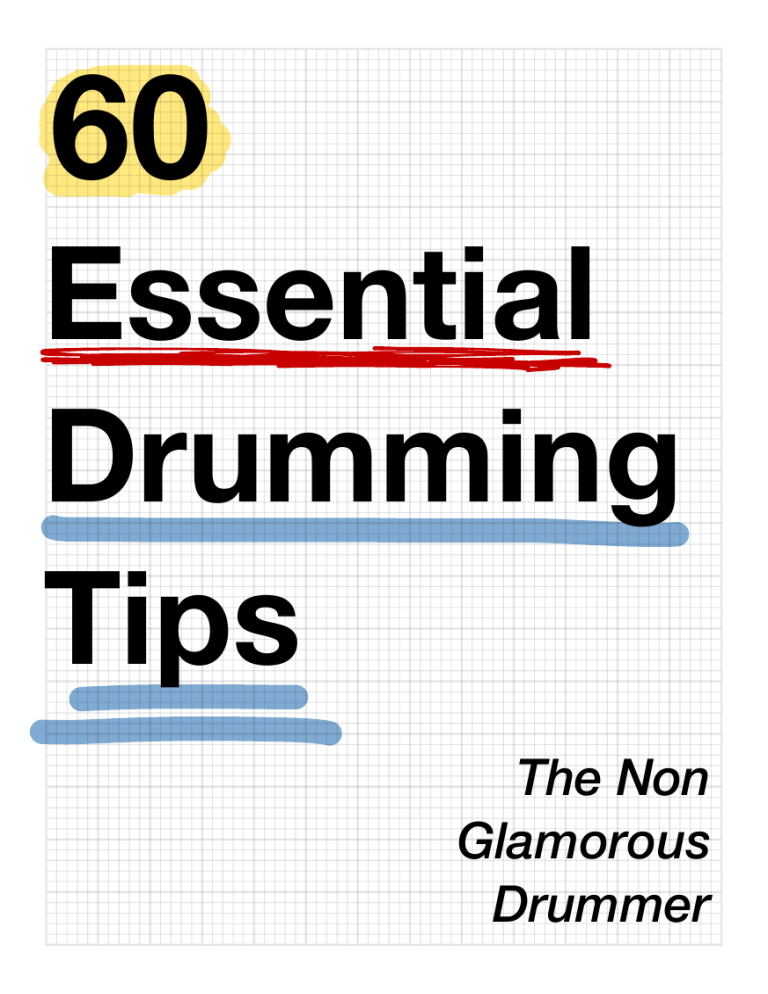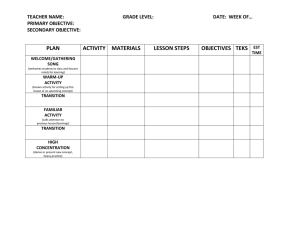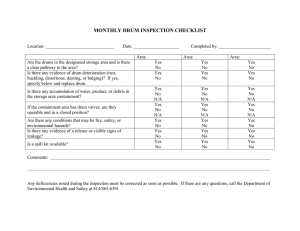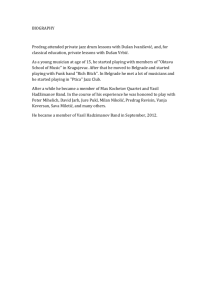
60 Essential Drumming Tips Itchy The Non Glamorous Drummer Copyright 2019 by Stephen Clark. All rights reserved. No parts of this book may be reproduced nor transmitted by any form without the prior written permission of the author. If you find this content to be valuable and worth sharing, please direct others to purchase a copy (through the means by which the author has made it currently available). This book may be small, but a good deal of time and hard work went into creating this document. Thank you for your support, and thank you in advance for your honesty! Most of this publication is based upon the author’s knowledge and experience on the subject. Although some topics presented do enter into the realm of subjectivity (this is music, after all), they are presented in the most accurate, correct way possible as it relates to drumming. Although the author has made every reasonable attempt to ensure complete accuracy, he claims no responsibility for any errors or omissions discovered in this document. I’m glad you’ve downloaded the “60 Essential Drumming Tips” booklet! Though short and simple, I hope that these tips will accelerate your learning. Many of these tips are just pieces of advice I’ve personally learned from lots of practicing and playing. A lot of these, however, are tidbits of wisdom told to me from older and wiser musicians. Nonetheless, a lot of these pieces of information are codes I live by and “play” by in the drumming world. While this quick booklet isn’t an encyclopedia of all-things-drumming, I do believe that you’ll be able to gain some valuable insight regardless of your experience or skill level at the drums. I’ve highlighted and underlined phrases or lines that have been most important pieces of wisdom to me personally through all of my playing and learning. This will give you an idea of what I believe to be the most important and most essential out of the 60 tips. I hope you enjoy! Gigging ① When playing in a small room, don’t tune your snare super high. Unless it absolutely needs to be cranked, tune to a more “medium” range. This will bring the volume down a bit and help the drum to sound nicer in context. ② Always carry an extra bass drum pedal in your trunk. You never know when something might go wrong with your primary pedal, and a backup could save your life on a gig. ③ Carry a few extra cymbal sleeves and felts with you. Way too many house kits are missing these, and you don’t want to have to put your cymbals directly onto the metal on the cymbal stand. ④ Keep a drum rug in the backseat of your car at all times. This is probably the most essential piece of gear there is in a drummer’s setup, and you NEVER want to forget this. ⑤ When playing in a small room, think about how the groove needs to “feel,” and adjust your dynamics accordingly. Don’t hit the cymbals too hard, but make sure the kick and snare are consistent. ⑥ In an “un-miked” situation, remember that you’ll need to play your kick drum the loudest, followed by toms and snare. The cymbals will need to be the quietest. Following this order of volumes will keep your kit balanced and pleasing to the ear in a small acoustic space. ⑦ Almost EVERY time that “the drummer is too loud,” it’s not the drums that are too loud. It’s the cymbals. Keep that in mind. ⑧ There ARE scenarios when the drummer gets blamed for the band being too loud, but often guitarists are guilty. Even a lead vocal mic may be turned up too loud. Keep in mind that this is sometimes the case, and be sure to handle these situations tactfully. ⑨ The gig is pretty much NEVER about you (maybe unless you’re the Buddy Rich Big Band and you’re Buddy Rich). Always seek to support the other musicians, having the goal of making the song feel the best it can feel. ④ When in doubt, play less notes. IT ÷ ④ When in doubt, quiet down a little. - Most likely the tendency is for you to rush in the excitement and adrenaline of the moment. Keep a strong focus on your time, and be sure to relax throughout the gig. Play every gig as though it were the gig of your life. Give every playing opportunity your full attention and full effort. This is how you quickly gain experience and grow as a player. ④ Make your primary goal for the night to listen to the lead vocalist. Remember that the melody determines all the other “parts” played in a song. Let the melody determine your groove and your fills. ④ Make “time” a priority. Don’t ever take your focus off playing with good time. Even if the gig lasts 4 hours, maintaining a focus on time will mean that your groove feels musical and solid for the whole night. ④ It’s ok to have a “low energy” night. That happens to all of us, and be prepared to focus on the core essentials when this happens. Direct your focus and energy (what little you may have) on remembering song form and playing with good time. Play fewer notes. ④ You, the drummer, need to know the song form better than anyone else in the band. Know exactly how the song goes, and know when other key parts come in. Know the melody, and be able to sing the song in your head. ④ Play with “intention.” This doesn’t always mean playing loud or playing simple. It just means that whatever you play (whether loud or quiet, simple or complex), play it like you mean it. This mindset leads to precision and musicality - both great things. Practicing: ④ A little bit can go a long way with practicing. It’s more important to practice a little bit many times, than a “lot bit” few times. Try to play for a few minutes every day, even if you’re just practicing single strokes on a pad. ④ Have very specific goals in your practicing. This is especially important when time is limited. Don’t sit down at your kit without a clear idea of what you’re working on today. ④ The 80/20 rule (a.k.a. - the “Pareto Principle”) rings true in the world of practicing. This rule states: “For many events, roughly 80% of the effects come from 20% of the causes.” We can flip this around to say: “For many events, roughly 20% of the effort generates 80% of the results.” Keep this “law of productivity” in mind as you practice. Most of what you work on won’t actually generate big results. Find the tasks that do, and spend more time on those in your practicing. ④ Avoid the urge to break out into a free-form drum solo while practicing. Or at least do this for 2 minutes at the beginning of the session so that you get it out of your system. Stay focused, and devote another specific portion of time to improvisation and soloing. ④ Turn your phone off (or leave it in another room) while practicing. If you’re using it to run a metronome or listen to the song you’re practicing, at least put it on airplane mode. ④ Prepare for your practice time. Sometimes a little bit of preparation can save you lots of time during the session. Decide what you’re going to work on, and make a list of priorities. If time’s limited, you’ll make sure to get the key things done quickly. ④ Don’t “sound good” all the time in your practicing. If that’s the case, you’re not really practicing. On the other hand, if you sound awful most of the time…but those “awful” things are improving into good things...you’re probably doing something right. ④ Practice like you’re the worst musician in the world so that you can perform like you’re the best musician in the world. ④ The saying, “quality over quantity” applies very much to practicing. Little bits of quality practicing (where you’re making lots of progress) are more productive than long sessions of not really getting much done. ⑧ During a day filled with practicing, be sure to take breaks often. If you’re really seeking to make lots of progress and improve your playing, your brain will need a break every so often. Don’t try to pride yourself in practicing for 9 hours straight. Learning Songs: ④ The first step to learning a song on drums isn’t to sit down at the kit and jam along. Be sure to strictly LISTEN to the recording first. The more time you spend just listening to the recording, the better you’ll actually know the song, grooves, and fills. ③ Have some sort of chart-system or song-memory system. Whether you memorize song forms well, or you have a “cheat-sheet” charting method, have some sort of way of confidently “knowing” a song. ③ Charting Tip: You usually don’t need to write out every detail of a song, unless it’s a very complex big band, funk, or fusion song. Most of the time you can make notes of how long each section is, then you can write in any other important details like fills, breaks, grooves, etc. ④ Spend some time practicing key parts of the song before you “run it” with the recording. Sometimes jumping in a little too quick can be frustrating. You often realize you’re rushing a fill or not actually playing the groove right. Make sure to nail down details first. ④ When you understand the song form, you “know” the song, and you’ve practiced key difficult parts, you’re now ready to play along to the recording. When doing this, be sure to have the recording playing through headphones that isolate sound well. ④ If perfection is your goal (you’re learning the song note-for-note), it doesn’t hurt to record yourself. Make a “drum cover” recording/video of you playing along to the song. You can now closely evaluate yourself and see how well you’ve done. at Gear: ④ Don’t get too hung up on it. Even the best gear won’t necessarily make you sound good. Great sounding drums and cymbals may inspire you and motivate you to practice, but it’s your responsibility to tie all of that together and create a cohesive drum sound. ⑧ You can get by with inexpensive drums, but you’ll eventually need to make an investment in good hardware and good cymbals. As far as hardware goes, at a minimum you’ll need a good bass drum pedal, a good hihat stand, and a comfortable throne. - ④ - - Drum tuning doesn’t have to be over-complicated. Make it a goal to get the drums “feeling” right (by tuning the top heads), then adjust the resonant heads to provide the amount of resonance and body you desire. ⑧ Keep in mind that the precise tuning of your drums is constantly changing. Whether the tension rods are wiggling loose, or you’ve simply moved your drums into a differentsounding room, the perceived “tuning” likely won’t stay the same. Think of drum-tuning as more of a process than an event. ④ Don’t muffle a drum just for the sake of muffling it. Listen to it wide-open (no muffling), then add gaff tape, moongels, or your other favorite muffling method as needed. ④ Ideally, don’t even put muffling on your toms unless you’re going for a “deader” sound. If there’s excessive ring coming from a drum, try detuning one of the lugs (probably from the bottom head) to kill the excess ring. Sometimes you don’t actually need muffling! ④ Be careful that you don’t tune so low as to lose the tone of your drums. Remember that the tone and resonance is what carries over to the audience’s ears - not the low end rumble you feel behind your kit. ④ Unless you’re going for a totally dead kick drum sound, don’t over muffle. Allow some room for resonance and tone, which will sound much nicer in a small acoustic space. This will also allow for more “body” and “beef” in a recording scenario. ④ If you’re trying to get rid of an annoying ring in the snare, try to eliminate it by detuning one of the top lugs a little. If that doesn’t work, try the next tip. ④ Rather than muffling your snare with tape or moongel, find a “hard” object you can place on the head. Something relatively small and lightweight is the best. This will serve to shorten the overtones, rather than eliminate them. Experiment with this, because you just might stumble upon a great snare sound. Recording: ④ Record yourself regularly. Better yet, record yourself at a gig. Even better yet… have the sound guy record the gig. Listening back to yourself in the context of other musicians can be extremely enlightening. ④ All you really need to get started recording is your phone. Most smartphones and tablets record pretty decent audio these days, and this is fine for listening to yourself and evaluating your playing. ④ Record rehearsals with your band / group you play/jam with. There’s nothing worse than having a rehearsal, then forgetting what you rehearsed a week later. Record what you worked on! 480 A great drum sound starts with the drum overhead mics. A drum mix with lots of overhead and less close mic is the key to a natural-sounding recording. ④ If you’re just starting out recording, all you need are 2 (maybe 3) microphones. Have either a stereo condenser mic mounted above the kit or two condensers mounted over the kit (as a stereo pair). Have a mic on the kick drum also, whether it’s inside our outside the bass drum. Just this simple setup alone will sound natural and musical. Believe it or not, most of John Bonham’s drum sounds with Led Zeppelin were recorded with only three mics. ⑤ In order to run a multi-mic setup, all you’ll need is an audio interface to connect to your computer and to plug the microphones into. Assuming you already have a computer, you can get a simple setup up and running for a few hundred dollars. ④ When listening to recordings of yourself, pay attention to what “feels” good and what doesn’t. If you can break this down and determine what you’re playing that sounds bad (and what sounds good), you’ll suddenly be well on your way to sounding a thousand times better. ⑤ Cleanliness and precision are essential when recording drums. If anything is sloppy, that’s going to be exposed on the recording. Practice a sloppy part slowly until it’s solid and comfortable. ④ Be hyper-aware of dynamics when recording. Know how loud “loud” is and how soft “soft” is. Make sure you’re hitting that “loud” dynamic each chorus, and make sure it’s consistent every time. ④ Be sure to play your backbeats consistently. Every snare hit needs to sound the same. Obviously there are intricacies like “ghosting” or “accents” that don’t all sound the same, but make sure your “2 & 4” are consistent and solid throughout a groove. ⑤ Decide whether or not to “bury” or “bounce” the bass drum beater. Depending on how your drum is tuned and muffled, these two techniques can make a big difference. Be consistent and intentional in whatever you do. Further Learning: Never stop learning, regardless of your age or skill level. TEST If you’re able to take private lessons from a great teacher, most definitely do so! However, if this isn’t a possibility, do your best to seek out quality instruction. You have to essentially become your own teacher, evaluating yourself as you work on new skills and techniques. ⑧ In the busy online world filled with thousands and thousands of “drum lesson videos,” be sure to take everything with a grain of salt and ask yourself: Is this something I NEED to work on right NOW? ④ Stay focused on the core drumming essentials that benefit your playing as a whole. Let these things dominate your practice time (remember the 80/20 rule?). You can add in other “extra-curricular” practice topics on top of these core things you work on every day if you like….(topics like… 16th paradiddles at 240bpm, double bass metal grooves, fiery Latin pattern in 7/8, you get the idea.) These things are fine to work on, but don’t let them be the ONLY thing you’re practicing. Stay focused on the basics all the time. j ⑧ Be honest and realistic with yourself. Be a critic of your playing, but don’t be a perfectionist. There are many iconic records out there that aren’t “perfect.” They weren’t recorded to a click, the drummer rushed a little in the chorus, that fill couldn’t be quantized to a grid if you tried…you get the idea. Be able to listen to yourself and identify your strengths and weaknesses. Know where you stand. Know what you’re good at and what you need to work on. Take practicing seriously…but don’t take yourself too seriously. Remember that music is ultimately all about having fun and fulfilling a deep desire we all have to express ourselves and tap into a universal language that goes beyond math and sound waves. - g-



